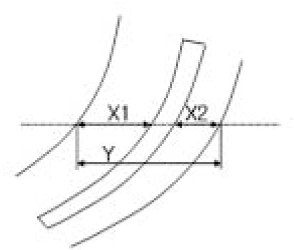J Korean Acad Conserv Dent.
2005 Nov;30(6):486-492. 10.5395/JKACD.2005.30.6.486.
The effect of different flute design and torque-controlled motor on the shaping ability of simulated resin root canals
- Affiliations
-
- 1Department of Conservative Dentistry, School of Dentistry, Pusan National University, Korea. jeongkil@pusan.ac.kr
- KMID: 2175757
- DOI: http://doi.org/10.5395/JKACD.2005.30.6.486
Abstract
- The purpose of this study was to compare the shaping ability of the two different Ni-Ti file systems and the two different engine systems in simulated canals. A total of four groups of each 10 were tested. Each group was instrumented with HeroShaper(R)and Endo-Mate2(R) (Group HE), HeroShaper(R) and Tecnika(R) (Group HT), ProFile(R) and Endo-Mate2(R) (Group PE), and ProFile(R) and Tecnika(R) (Group PT). Canal preparation time was recorded. The images of pre- and post- instrumented root canals were scanned and superimposed. The amounts of increased width and centering ratio were measured and calculated at apical 1, 3 and 5 mm levels. These data were statistically analyzed with one-way ANOVA and Duncan's multiple range test The results of this study were as follows; 1. Canal preparation time of HT group was the shortest (p < 0.05). 2. The amount of increased canal width in HE group was significantly larger than PT group at apical 1 mm level (p < 0.05). At apical 3 mm level, PT group was significantly smaller than other groups (p < 0.05). At apical 5 mm level, PE group was significantly larger than PT group (p < 0.05). 3. The amount of centering ratio in HE group was significantly larger than other groups (p < 0.05). At apical 5 mm level, HT group was significantly larger than PE group and PT group (p < 0.05). Under the condition of this study, torque-controlled endodontic motor is safer than no torque controlled motor, especially when the active file is used.
MeSH Terms
Figure
Reference
-
1. Gambarini G. Rationale for the use of low torque endodontic motors in root canal instrumentation. Endod Dent Traumatol. 2000. 16:95–100.
Article2. Morgan LF, Montgomery S. An evaluation of the crown-down pressureless technique. J Endod. 1984. 10:491–498.
Article3. Davis RD, Marshall JG, Baumgartner JC. Effect of early coronal flaring on working length change in curved canals using rotary nickel-titanium versus stainless steel instruments. J Endod. 2002. 28:438–442.
Article4. Sattapan B, Nervo GJ, Palamara JE, Messer HH. Defects in rotary nickel-titanium files after clinical use. J Endod. 2000. 26:161–165.
Article5. Suffridge CB, Hartwell GR, Walker TL. Cleaning efficiency of Nickel-Titanium GT and .04 Rotary Files when used in a torque-controlled rotary handpiece. J Endod. 2003. 29:346–348.
Article6. Haikel Y, Gasser P, Allemann C. Dynamic fracture of hybrid endodontic hand instruments compared with traditional files. J Endod. 1991. 17:217–220.
Article7. Wildey WL, Senia ES, Montgomery S. Another look at root canal instrumentation. Oral Surg Oral Med Oral Pathol. 1992. 74:499–507.
Article8. Bahcall JK, Barss JT. Understanding and evaluating the endodontic file. Gen Dent. 2000. 48:690–692.9. Averbach RE, Kleier DJ. Endodontics in the 21st century: the rotary revolution. Compend Contin Educ Dent. 2001. 22:27–34.10. Camps JJ, Pertot WJ. Torsional and stiffness properties of nickel-titanium K files. Int Endod J. 1995. 28:239–243.
Article11. Schneider SW. A comparison of canal preperations in straight and curved root canals. Oral Surg Oral Med Oral Pathol. 1971. 32:271–275.12. Kuhn WG, Carnes DL Jr, Clement DJ, Walker WA 3rd. Effect of tip design of nickel-titanium and stainless steel files on root canal preperation. J Endod. 1997. 23:735–738.
Article13. Calhoun G, Montgomery S. The effects of four instrumentation techniques on root canal shape. J Endod. 1988. 14:273–277.
Article14. Kosa DA, Marshall G, Baumgartner JC. An analysis of canal centering using mechanical instrumentation techniques. J Endod. 1999. 25:441–445.
Article15. Buchanan LS. The standardized-taper root canal preperation-Part 1. Concepts for variably tapered shaping instruments. Int Endod J. 2000. 33:516–529.
Article16. Coleman Cl, Svec TA. Analysis of Ni-Ti versus stainless steel instrumentation in resin simulated canals. J Endod. 1997. 23:232–235.
Article17. Blum JY, Machtou P, Micallef JP. Location of contact areas on rotary Profile instruments in relationship to the forces developed during mechanical preperation on extracted teeth. Int Endod J. 1999. 32:108–114.
Article18. Yared G, Kulkarni GK. Accuracy of the DTC torque control motor for nickel-titanium rotary instruments. Int Endod J. 2004. 37:399–402.
Article19. Glossen CR, Haller RH, Dove SB, del Rio CE. A comparision of root canal preperation using Ni-Ti hand, Ni-Ti engine-driven, and K-Flex endodontic instruments. J Endod. 1995. 21:146–151.
- Full Text Links
- Actions
-
Cited
- CITED
-
- Close
- Share
- Similar articles
-
- A comparison of the shaping ability of reciprocating NiTi instruments in simulated curved canals
- Influence of glide path on the screw-in effect and torque of nickel-titanium rotary files in simulated resin root canals
- A comparative study of the canal configuration after shaping by protaper rotary and hand files in resin simulated canals
- Shaping ability of nickel-titaniumrotary files
- Relative efficacy of three Ni-Ti file systems used by undergraduates



